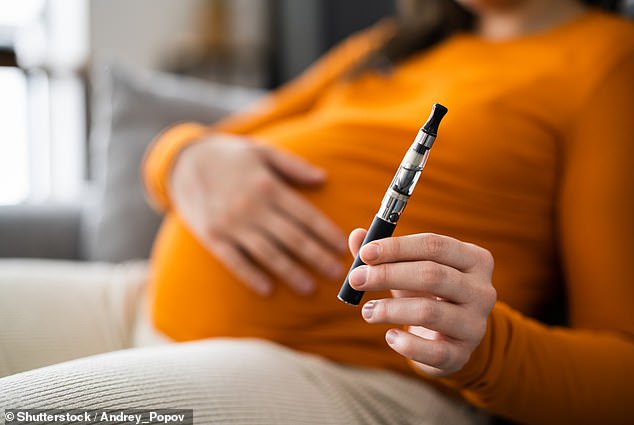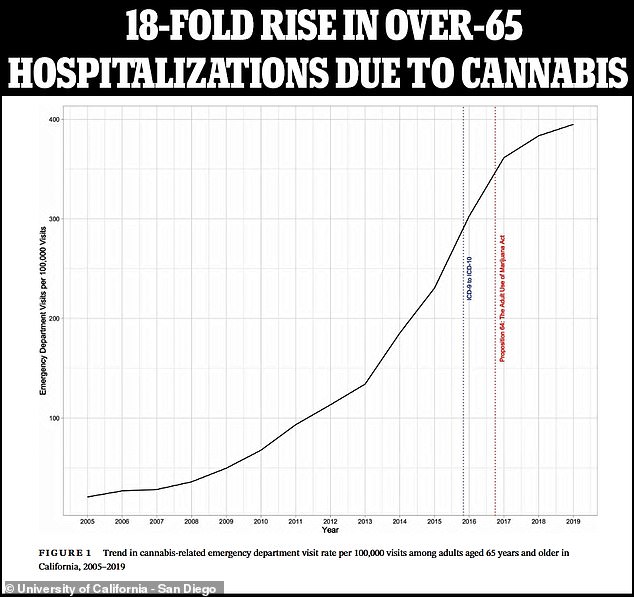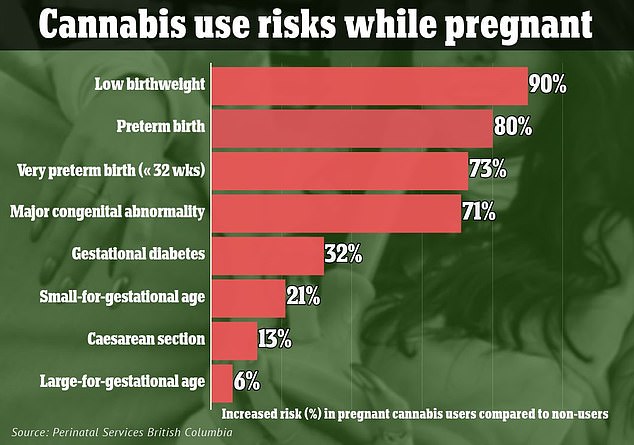Exposure to marijuana in the womb has a surprising effect on a child’s development, research suggests
New research shows that babies exposed to marijuana in the womb showed higher language abilities than those who were not exposed to the drug in the womb.
Scientists from Illinois and South Dakota were surprised by their findings, which showed that children whose mothers smoked marijuana during pregnancy had developed language and motor skills greater than those of children whose mothers did not use the drug.
However, experts caution that the results don’t mean expectant mothers should start consuming weed, as it has also been shown to cause neurodevelopmental problems in infants, as well as low birth weight, similar to the harm associated with drinking during pregnancy.
And while their increased language and motor skills may lead these children to perform better in school than children who have not been exposed, further research is needed to study the link.
Recreational marijuana is legal in 24 states, although others have legalized it for medicinal purposes only

Researchers were surprised by their findings, which showed that by the age of one, the children exposed in utero had developed language skills that exceeded those of unexposed children.
The authors of the study, published in the journal Frontier in pediatricssaid: ‘Exposed infants showed higher expressive and receptive language scores at 12 months of age, which may translate into better performance in school.
‘However, further research is needed to determine the implications of these results later in childhood.’
The 207 mothers who participated in the study and their babies were assessed 12 months after the mothers submitted questionnaires about their cannabis use and their child’s development.
Cannabis use was classified as early in pregnancy and in the second or third trimester.
Infants were assessed using the Mullen Scales of Early Learning (MSEL) assessment instrument, which evaluates gross motor skills, fine motor skills, visual reception, receptive language, and expressive language skills.
Of the two groups of babies, 69 were exposed to cannabis in the womb, and 138 were not. Children exposed early in pregnancy were more likely to have improved gross motor skills.
Based on the findings, researchers concluded that scores for early exposed babies could be between 1.75 and 13 points higher than those of unexposed babies.

Meanwhile, the range of scores for receptive language (a child’s ability to understand words, sounds, and images) was 0.4 to nearly nine points higher in babies exposed to marijuana later in pregnancy than in babies who were not did.
Lately exposed infants may also have elevated expressive language scores (a child’s ability to use words and form sentences) that can be anywhere from 2.5 to almost 13 points higher than unexposed infants.
THC is the psychoactive chemical in cannabis and can cross the placenta and affect the developing fetus.
A survey in the journal Naturopathy examined birth registry data in Ontario, Canada, studying all live births from April 1, 2007 to March 31, 2012.
It found that for every 1,000 person-years of observation, four cases of autism spectrum disorder were diagnosed among children exposed to cannabis.
Person-years reflect the total time of observation or follow-up for all subjects included in the study, adjusted for the number of people and the length of time each was followed.
Another study in the journal Canadian general practitioner found that babies born to women who used cannabis in newborns had a “withdrawal syndrome,” evidenced by an increase in startle and tremors and a decreased ability to adapt to light.
In preschool, children exposed to cannabis during pregnancy began to show problems with verbal and visual reasoning, hyperactivity, attention deficits and impulsivity.
These problems were seen in both study groups and persisted throughout their school years. At age 10, these children also began showing signs of depression and anxiety.
These emotional symptoms were associated with earlier cannabis use and lower performance in adolescence and early adulthood.

A study published last year by Perinatal Services British Columbia found that marijuana use during pregnancy was most commonly linked to low birth weight, preterm birth, birth defects, gestational diabetes and an increased risk of cesarean section.
In some parts of the US, up to a quarter of pregnant women use marijuana during pregnancy, a study in the journal found JAMA found it.
And in 2022, researchers in Canada found that one in fifty pregnant women used cannabis in legalized areas.
The same study found that expectant mothers who used cannabis were 32 percent more likely to be diagnosed with gestational diabetes, and 13 percent more likely to have a cesarean section, increasing the risks for both mother and baby during labor.
Researchers behind the latest study said: ‘Based on concerns about impaired neurodevelopment and maternal and fetal exposure to smoking, the American College of Obstetricians and Gynecologists (ACOG) recommends avoiding cannabis use in women who are pregnant or considering pregnancy. ‘
Their research suggests that the stage of pregnancy at which the child is exposed to marijuana matters, potentially affecting areas of the brain that contain cannabinoid receptors.
Still, they offered no explanation for why the drug might cause this benefit in some babies.
The legalization of marijuana in the US, implemented in 24 states for recreational use, has initiated a progressive experiment into the effects of cannabis use on populations young and old, pregnant and not.
US drug officials recently announced they would reschedule marijuana to remove it from the Schedule One category, which placed it in the same category as heroin, to schedule three, with the likes of testosterone and ketamine.
The proposal, which will be reviewed by the White House Office of Management and Budget (OMB), would recognize that it has less abuse potential than some of the nation’s most dangerous drugs, such as heroin and MDMA.
At the same time, the disadvantages of marijuana use are becoming increasingly clear. At least 290 American children have suffered brutal, preventable deaths from marijuana in the past decade.
The highest percentage of deaths – 95 – involved extreme violence, including the case of a Texas man who killed his girlfriend and a nine-month-old baby with a pocket knife while suffering from what was believed to be a cannabis-induced psychotic episode.
It also appears to be the driving force behind an increase in car accidents. A DailyMail.com/TIPP survey of 1,435 adults found that 52 percent said cannabis use caused the number of vehicle crashes.
Meanwhile, the 12.5 million stoned drivers who got behind the wheel marked a 15 percent increase on the previous year.
